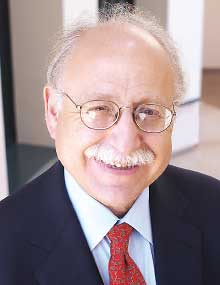Schatzberg Honored for Research Connecting Cortisol and Psychotic Depression
Alan Schatzberg, M.D., the Kenneth T. Norris Jr. Professor of Psychiatry and Behavioral Sciences at Stanford University, started his 2018 Judd Marmor Award Lecture with a confession. “Maybe I’m not very smart,” he said. “Or maybe nobody is smart. But I think clinical advancements require the daily grind of many dedicated individuals.”
 Schatzberg, who is also a past APA president, provided that explanation in advance of his retelling the decades of work of his lab and colleagues to connect the HPA (hypothalamic-pituitary-adrenal) axis with psychotic major depression. This disorder is a common subtype of major depression (estimates suggest 1 in 6 people with major depressive disorder has the psychotic subtype) in which patients develop delusions, though ones not as disorganized as in schizophrenia. Schatzberg commented that these patients usually retain enough self-awareness, so that they don’t share their unusual thoughts or beliefs, which can make diagnosis difficult.
Schatzberg, who is also a past APA president, provided that explanation in advance of his retelling the decades of work of his lab and colleagues to connect the HPA (hypothalamic-pituitary-adrenal) axis with psychotic major depression. This disorder is a common subtype of major depression (estimates suggest 1 in 6 people with major depressive disorder has the psychotic subtype) in which patients develop delusions, though ones not as disorganized as in schizophrenia. Schatzberg commented that these patients usually retain enough self-awareness, so that they don’t share their unusual thoughts or beliefs, which can make diagnosis difficult.
Schatzberg said that in most cases, these delusional episodes are triggered by some stressful external event (loss of money, divorce, and so on), which first suggested that stress and stress hormones might play an important role. “We knew that taking too many steroids can induce mania and psychosis,” Schatzberg said. “Maybe there was a similar phenomenon with psychotic major depression.”
To follow up on this idea in the early 1980s, Schatzberg and others administered dexamethasone suppression tests (DST) to patients who reported depression and psychosis. This test temporarily suppresses production of cortisol, a steroid hormone that acts as the body’s stress response. Compared with individuals with nonpsychotic depression or bipolar disorder, people with psychotic major depression had less suppression of cortisol production in response to the DST, which supported the idea that these patients were in a more hyperaroused state.
Follow-up studies in which patients had their blood taken at various times throughout the day confirmed this deficient cortisol suppression response. During the day, the cortisol levels of patients with psychotic depression were not much different from those of patients with nonpsychotic depression or controls, but at night—when cortisol levels normally drop to let the body rest—patients with psychotic major depression had higher cortisol levels than the other two groups.
With improved neuroimaging in the 1990s and 2000s, brain scans confirmed that there was a plethora of receptors in the brain, especially in the prefrontal cortex, a key region for the regulation of emotions and behaviors. The researchers hypothesized that reducing cortisol levels in patients with psychotic major depression might in turn reduce symptoms of psychosis.
“It’s hard to block production of the hormone for any extended period, because the body senses something is wrong and fights back,” Schatzberg explained. However, by blocking the cortisol receptor, Schatzberg proposed he might be able to achieve the same effect. He turned to mifepristone, a drug that can block both progesterone and cortisol receptors. In the late 1990s, Schatzberg cofounded the company Corcept to explore whether mifepristone could be used to treat major depression. (He has had no role in the company for years but still retains some equity in it.)
Though primarily an abortion drug, mifepristone is also approved to treat Cushing’s disease, a rare disorder caused by tumors in the pituitary gland, also known to give rise to symptoms of psychosis. Several clinical studies have since been conducted in patients with psychotic major depression, with encouraging results, Schatzberg said.
“The drug works well if you can get a high enough concentration in the blood, something around 1,600 nanograms per milliliter or higher,” he said. “And it’s also remarkably well tolerated if taken only for a week [for episodes of acute psychosis], though naturally you would not give this to anyone who might be pregnant.”
Schatzberg acknowledged that mifepristone would likely not be approved for treating psychotic major depression, as the FDA typically does not want medications to have qualifications like a minimum blood concentration that patients would have to monitor regularly. However, the success of the clinical studies has spurred biotech companies to start developing “designer” medications that act on cortisol receptors that might be more potent and specific than mifepristone.
“I’m not sure if I’ve ever seen a more consistent biological association in psychiatry than nighttime cortisol levels and psychotic depression,” Schatzberg said. Given that, he thinks this story has to end with a clinical breakthrough.
The Judd Marmor Award was endowed in 1999 by Judd Marmor, M.D. It was established to honor a psychiatrist who has contributed to advancing the biopsychosocial model, which argues that biological, psychological, and social factors all play a critical role in the development and manifestation of disease.
|
|
|
|
|

